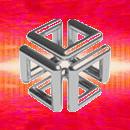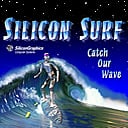Yes, it's on the middle PCB.
Careful how you extract the 2nd TRAM. Remove the end plate first (the one that goes over the monitor
and stereo socket), then remove the top 4 locking screws. When you bend the board upwads, don't
force it all the way to 90 degrees. Just keep it at around a 50 to 60 degree angle. Use a pair of tweezers
or needle-nose pliers to extract the plastic locking pins from each end of the TRAM. If you use anything
like a flat-bladed screwdriver to lift up the TRAM away from the PCB, be careful to do so at points on
the PCB where there are no surface mount components that could be harmed.
When you're testing a Max set, do so with either no TRAMs installed, or both. Don't try it with just one
TRAM. This is why I tried very hard to find a HighIMPACT set so that I could test TRAMs one at a time,
then move pairs onto a Max set once I had 2 TRAMs that are ok.
Also, do not test IMPACT boards with TRAM installed when the top-lid for the Indigo2 is not fitted.
Alternatively, use a separate fan to help cool the TRAM on the top board if the top-lid is not in place.
I use a fan connected to the molex cable of a disk sled in the upper disk bay.
In all the above, observe antistatic precautions and make sure the bottom PCB does not scrape
against any surface or object which might result in other surface mounted components failling off.
The most common fault with TRAMs is the Alpha channel. Use the tex_cube demo to check initial
Alpha functionality. The image should appear consistent whether the window is small or large. If it
works ok, check more complex Alpha features with the Macau demo - watch how trees and lamp
posts appear, look for artefacts around the billboard edges (press T to show the billboard shapes),
and also watch how building textures in the distance appear - they should not show any dithering
or 'rolling' pixel effects if the TRAM is working ok.
If the Alpha is working ok, I then test more basic texturing using the Mirrors demo, Matterhorn, Huge
Engine Model (including transparency mode, and test shading/wireframe with textures off), A10, F18,
and of course try an IrisGL task aswell (I use Beethoven model from buttonfly).
Other symptoms:
- If running a 3D app causes the display to lock up and then resets the X server back to the login
screen, this is normally a fault with the GE board. Often this is the case when the display looks ok
after initial power on and after the system has fully booted and logged in, ie. the DG and raster
elements are ok, but a bad GE isn't exercised until a 3D app is executed. This fault results in gfx
timeout errors in SYSLOG.
- If the display is already bad after initial power-on, ie. when the Press ESC for Maintenance message
appears (typically visible as lots of jagged horiztonal line effects), then this is normally a bad DG board.
- If the system makes a normal power on tune and sounds like it's booting ok, but the screen is black,
this can be the result of one of the TRAMs not being seated properly. Check by removing both TRAMs,
ensure the base Max set is ok, then refit the TRAMs, ensuring they are correctly seated.
If you decide to swap boards between Max sets, be very careful. Don't use the tiny levers to disconnect
the ribbon cables, they are too fragile; I use a small flat-bladed screwdriver to just lift up the connector
either side of the socket. Take the opportunity to remove any dust with a soft brush and/or inert air duster.
Don't bother using the PROM ide for testing, it's not accurate, often reporting false positives.
If you can, use the lower three slots to test Max sets. This gives better cooling for the TRAM at the top.
Ian.
(07/Mar/2015) FREE! (collection only) 16x Sagitta 12-bay dual-channel U160 SCSI JBOD units.
Email, phone or PM for details, or see my
forum post
.
[email protected]
+44 (0)131 476 0796
 R14K 600Mhz, V10, 4Gb, 147Gb
R14K 600Mhz, V10, 4Gb, 147Gb
 Dual R14K 600Mhz, Odyssey V12, 2Gb, 72Gb
Dual R14K 600Mhz, Odyssey V12, 2Gb, 72Gb
 R12K 400Mhz, CRM-C, 1Gb, 72Gb
R12K 400Mhz, CRM-C, 1Gb, 72Gb
 R10K 195Mhz, Max Impact/2/2/4, 320Mb, 147Gb
R10K 195Mhz, Max Impact/2/2/4, 320Mb, 147Gb
 HP XW6600 Dual Quad Core 3Ghz, GTX970, 16Gb, 500Gb SSD
HP XW6600 Dual Quad Core 3Ghz, GTX970, 16Gb, 500Gb SSD

 One with DISCiPLE Interface
One with DISCiPLE Interface















 ...
...
 -
-









